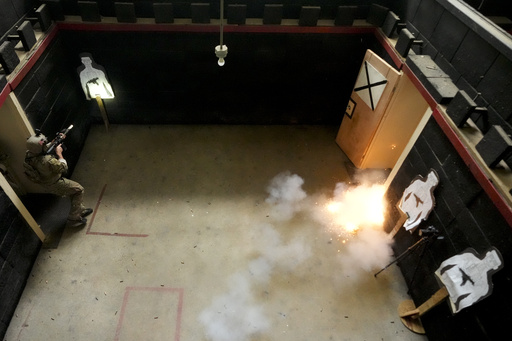WASHINGTON — The recent training exercise involving U.S. special operations forces was marked by a significant explosion that rattled the earth, accompanied by a vivid flash of flames engulfing a doorway as troops executed a door breach. In a subsequent attempt, however, the explosion was notably quieter and the flames less intense. This change highlights the implementation of innovative technologies aimed at minimizing brain injuries that have increasingly become a concern within the military.
In an effort to safeguard personnel, U.S. Special Operations Command is adopting various new strategies, which include mandatory testing, blast monitoring, and the redesigning of explosive charges to lessen the impact on soldiers. Their focus is on reducing the trauma associated with blast overpressure and accurately assessing potential health risks, particularly during training exercises.
“We have individuals eager to volunteer for these studies,” stated retired Sgt. Maj. F. Bowling, a previous special operations medic now working as a contractor with the command. “The matter is crucial to our community, and there is a substantial level of concern about it.”
Currently, the Department of Defense faces challenges in gathering precise data concerning the prevalence of blast overpressure injuries among troops, as these issues are often more elusive to detect than their more recognized counterpart, traumatic brain injuries. Although traumatic brain injuries have consistently posed a threat to combat personnel—especially those exposed to missile detonations and nearby explosions—the Defense Department’s Traumatic Brain Injury Center of Excellence noted over 20,000 diagnoses of such injuries last year alone, with more than 500,000 recorded since the year 2000.
Josh Wick, a spokesperson from the Pentagon, indicated that the latest findings suggest connections between both sudden and repetitive low-level blast exposures and various negative health outcomes, including sleep disturbances, impaired cognitive functions, headaches, and dizziness. “Ensuring the long-term cognitive health and operational effectiveness of our forces remains our top priority,” emphasized Gen. Bryan Fenton, who leads U.S. Special Operations Command, affirming their commitment to understanding the implications of blast overpressure on brain health.
Fenton explained that collaboration with academic and medical professionals, as well as industry experts, is vital for finding effective ways to mitigate and treat the impacts of blast overpressure. He underscored that cutting-edge technologies are essential to alleviating the effects of repeated exposures that many personnel encounter.
At a designated training site for Army special forces located at Fort Liberty in North Carolina, operators utilized a Muchete breaching charge tailored to precisely channel explosions while minimizing detrimental pressure waves generated during detonation. A limited group of journalists was granted access to observe the exercise.
“The reduction of blast overpressure affecting the operator typically ranges between 40 and 60%,” explained Chris Wilson, who leads the clinical research and performance initiatives within the command. “The actual level of exposure can greatly differ depending on an individual’s positioning during the exercise, but the decrease in overall exposure is quite significant—definitely a positive outcome.”
Wilson noted that while the improved breaching charge is still undergoing development and testing, units have already begun incorporating it into their training sessions prior to final approval for broader application.
Given the rigorous training regimen of special operations forces, which often involves numerous instances of breaching practice, soldiers are particularly susceptible to such repetitive exposures. As part of ongoing efforts to better understand individual impacts, many soldiers participated in the demonstration while wearing advanced sensors designed to monitor the levels of blast pressure experienced.
The command is currently exploring various blast monitoring systems available commercially, with intentions to expand their use among higher-risk personnel. Further testing and evaluations are set to continue, with expectations of rolling out these technologies across the broader force in the coming years.
According to Wilson and Col. Amanda Robbins, a psychologist within the command, there are clear distinctions between acute traumatic brain injuries and what is termed long-term blast exposure. Acute traumatic brain injuries are well documented and recognized, while repetitive blast exposure demands further investigation due to ongoing uncertainties regarding its effects on cerebral health.
To foster research efforts, Special Operations Command is considering enhanced routine testing throughout a service member’s career, which includes a neurocognitive assessment every three years. The initiative aims to ensure that service members with a history of concussions or similar injuries receive thorough evaluations.
In addition, the broader Defense Department has mandated cognitive assessments for all new recruits as a proactive measure against brain injuries linked to blast exposures. Recent guidance emphasizes greater utilization of protective equipment, establishing minimum safe distances during specific training activities, and reducing the number of individuals exposed to blasts.
Special Operations Command is also performing comprehensive assessments that focus on an individual’s injury history, including incidents dating back to childhood. This early-stage assessment serves to establish a baseline for future evaluations.
Robbins mentioned that newly enlisted operators, as well as seasoned personnel with 20 or more years of experience, are generally responsive to this kind of testing. “The challenge resides with mid-career operators who might be reluctant due to concerns about the implications of self-reporting,” she commented, highlighting that the assessments encompass incidents potentially not recorded in medical files, which could lead to early identification of problems and prompt treatment.


